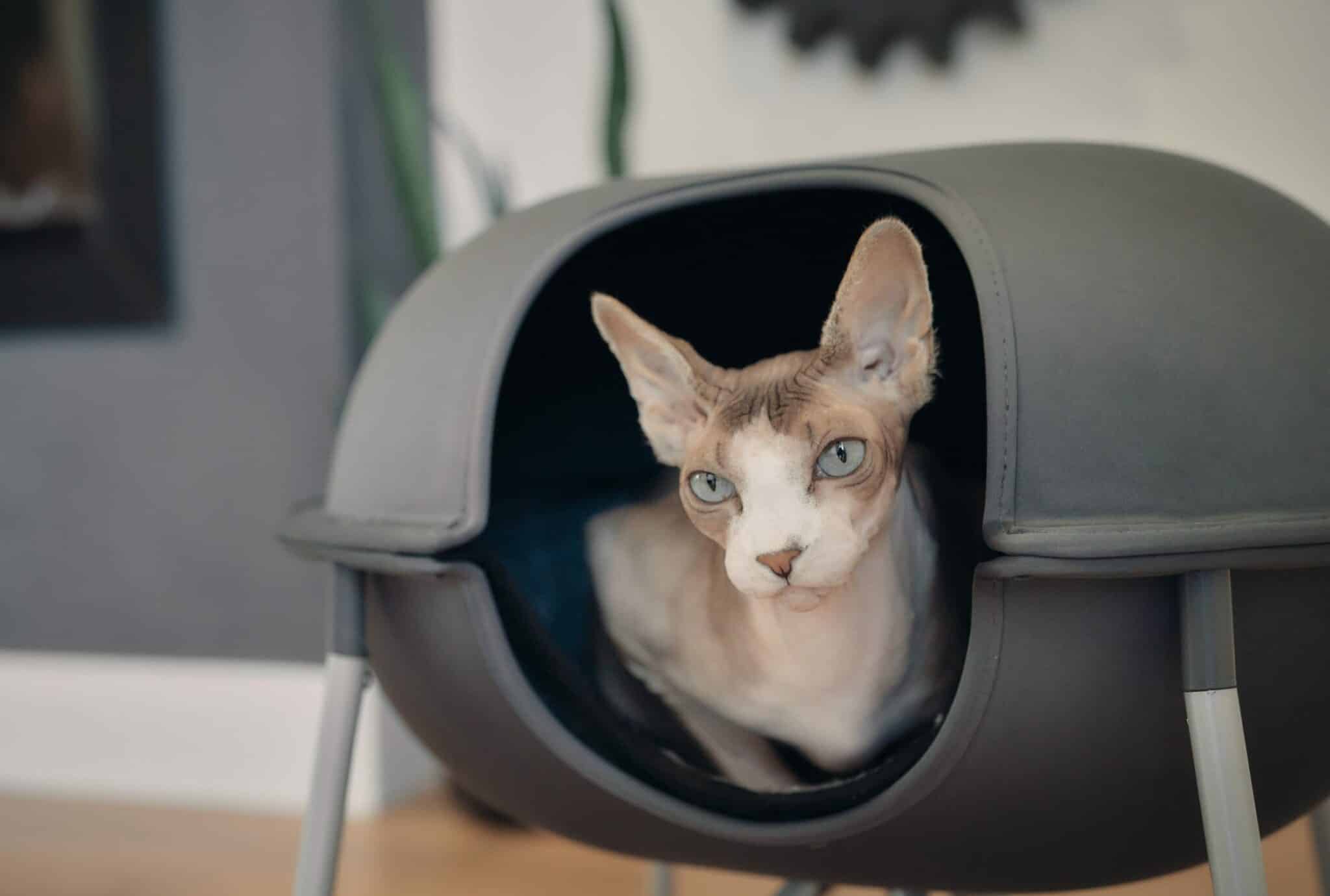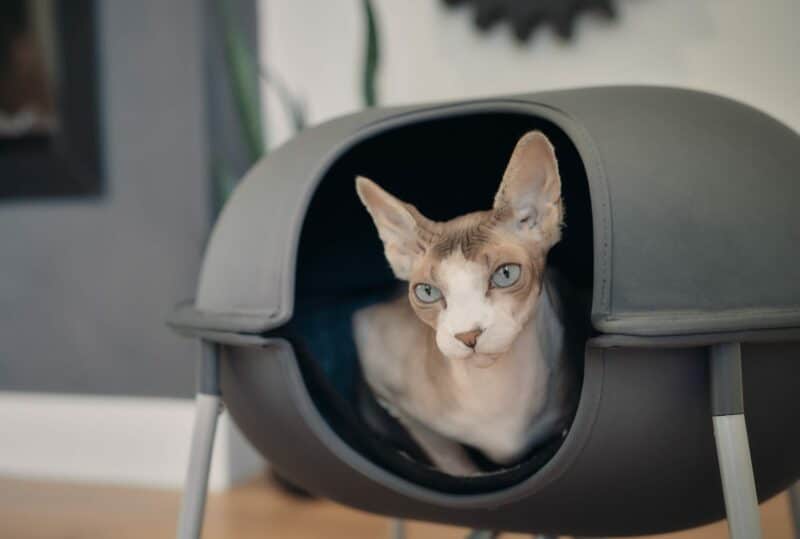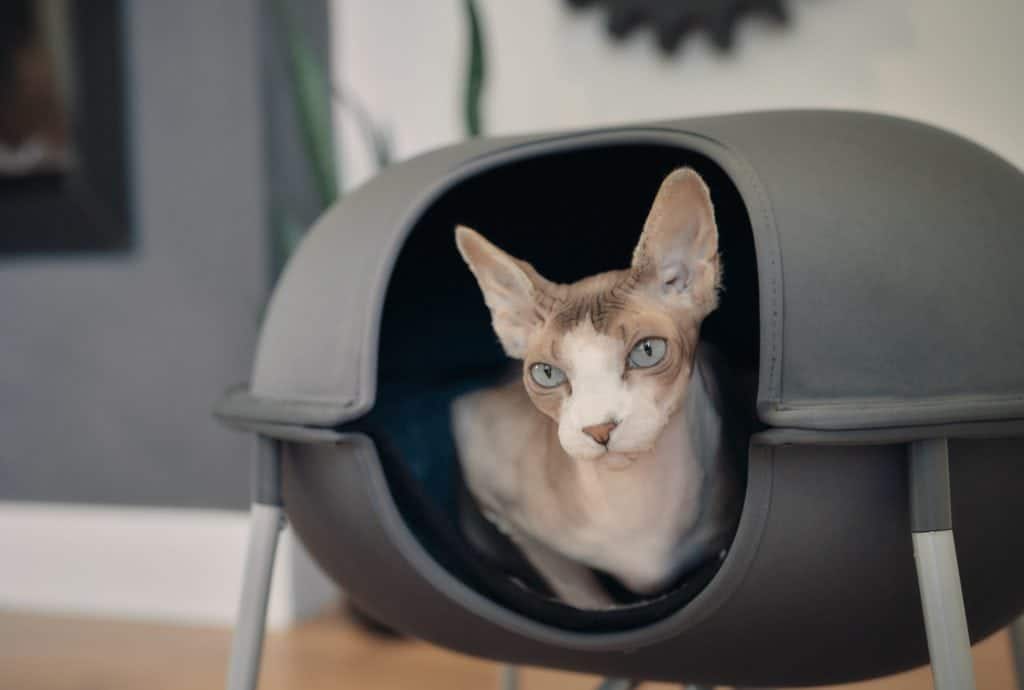
Some cats feel safe when they’re contained. Others? Not so much. For those that enjoy tight spaces and hiding, cat cave beds can be perfect. These are beds that have a roof and sides. In other words, they look like a cave. They make many cats feel hidden while they rest, which can help them relax.
Not all cat cave beds are made the same, though. Some are better for larger cats, while others are more suitable for multiple cats at a time. In this article, we’ll have a look at the best cat cave beds out there and help you choose the perfect one for your feline.
A Quick Glance at Our Favorites in 2024
| Image | Product | Details | ||
|---|---|---|---|---|
| Best Overall |
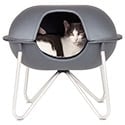
|
Hepper Pod Modern Cat Bed |
|
CHECK PRICE |
| Budget Buy |
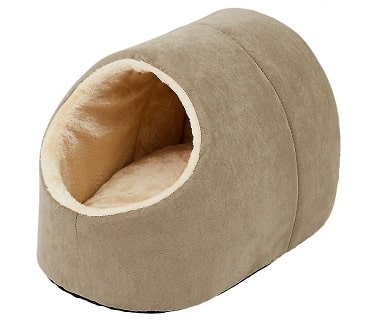
|
Frisco Cave Covered Cat Bed |
|
CHECK PRICE |

|
Snoozer Pet Products Cat Cave Bed |
|
CHECK PRICE | |
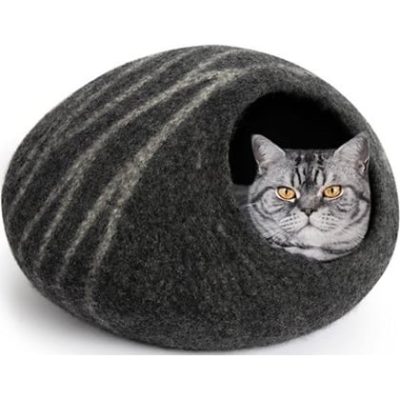
|
Meowfia Premium Cat Cave Bed |
|
CHECK PRICE | |
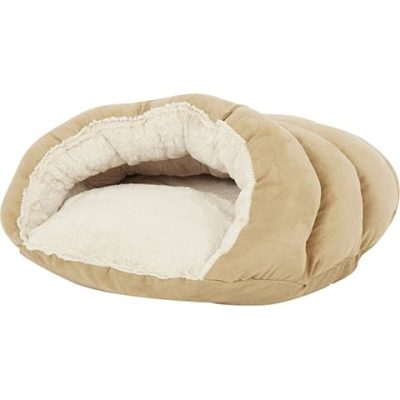
|
Ethical Pet Cat Cave Bed |
|
CHECK PRICE |
The 10 Best Cat Cave Beds
1. Hepper Pod Modern Cat Bed – Best Overall
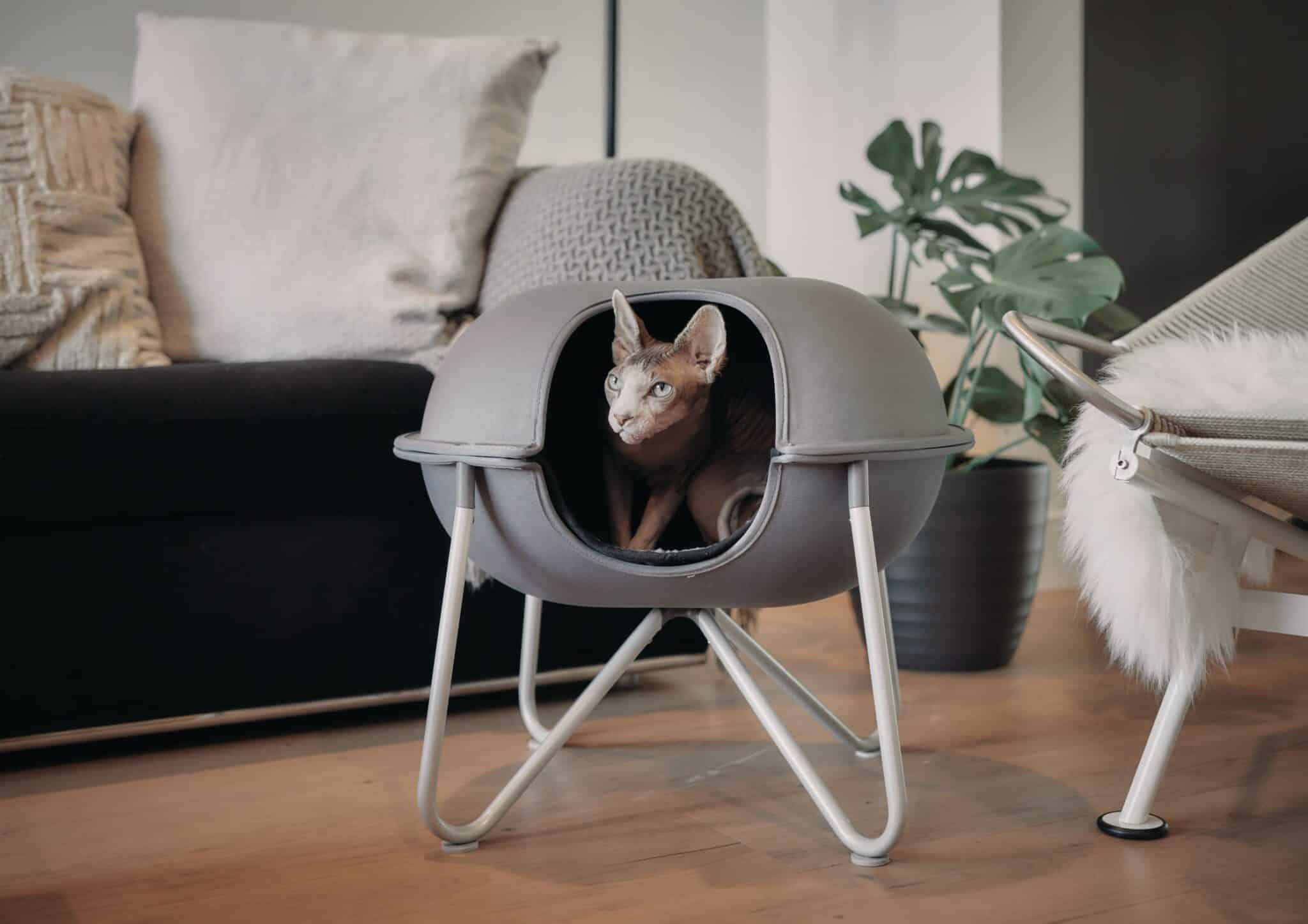
Out of all the cat cave beds out there, the Hepper Pod Modern Cat Bed is one of the best options. This cat bed has a modern vibe and is completely free-standing. It sits a bit off the ground, making it perfect for some felines that like to be up high. The inside is luxurious and warm, with plush fur lining the inside. The Sherpa fleece has a microfiber trim. It is entirely removable for cleaning purposes.
The cat bed is easy to assemble with only four screws. The base is solid and stable. All four legs are pretty far apart and durable. The large door is perfect for larger felines, though the bed is deep enough for smaller cats. The opening is also big enough to ensure appropriate airflow. The non-slip rubber pads underneath the legs prevent the bed from moving around when your cat jumps into it.
The inside has reinforced edging around the fleece liner to reduce wrinkles and folds. This makes it more comfortable for your feline and keeps the whole thing looking sharp.
At Catster, we’ve admired Hepper for many years and decided to take a controlling ownership interest, so that we could benefit from the outstanding designs of this cool cat company!
- Non-slip feet
- Plush lining
- Easy assembly
- Reinforced edging
- Large opening
- It might take some cats a bit of time to get used to
2. Frisco Cave Covered Cat Bed – Budget Buy

If you don’t want to spend much on a cave cat bed, you may want to consider the Frisco Cave Covered Cat Bed. This bed is designed for both cats and dogs. It is utterly machine-washable for those pesky messes that are sure to come with pets. The inside is filled with ultra-soft fabric, and the sleeping area is stuffed with polyester fiber. The exterior is even covered with suede material. The bed comes in a solid, neutral color, so it should fit with most home designs.
The bed is quite large, with a big enough opening for most cats. It is designed to be used for small dogs, so you can imagine that it doesn’t require any fancy maneuvers to get into. It is perfect for older cats that may not be able to climb like they once could. This is a perfect bed to put somewhere that your cat already likes to sleep, like on a table.
The main problem with this bed is that it may fall over. It isn’t super stable. If one of the sides is pushed too much, it will flip. Still, it is the best cat cave bed for the money.
- Stuffed with polyester
- Machine-washable
- Decently large
- Inexpensive
- Bed falls over
3. Snoozer Pet Products Cat Cave Bed

If you want only the best of the best for your feline, then you may want to purchase the Snoozer Pet Products Cat Cave Bed. This bed indeed provides your feline with a burrowing experience. The top hags down relatively low, allowing your cat to “burrow” into the bed. The hooded design makes this a great bed for many cats, but others don’t like it at all.
The inside has a Sherpa lining, which makes it very comfortable. There is a sturdy brass zipper on the bed for removing the stuffing. The cover is then washable, as well as the inside liner. The outside is made of polyester and cotton, with overlocked edges to ensure durability and longevity. It won’t fray, thanks to its sewing technique.
The polyester is even filled with cedar. This helps control odors and keeps all the insects away.
- Unique hooded design
- Filled with cedar
- Sherpa interior
- Machine-washable
- Hand-sewn in the USA
- Expensive
4. Meowfia Premium Cat Cave Bed
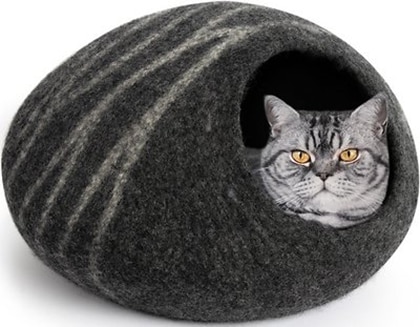
At about an average price, the Meowfia Premium Cat Cave Bed could also easily be your cat’s favorite bed. It is handmade by Nepalese artisans out of New Zealand Merion wool. The whole bed is made out of wool, which has been felted and formed into a bed. This makes the best extraordinarily soft and breathable. There aren’t any stitches to come undone. The wool will keep your cat cool in the summer and warm in the winter. It can indeed be used all year round.
This best wool cat cave bed is also flexible, so your cat can easily snuggle into the bed. Merino wool is naturally antibacterial. It repeals odor, doesn’t stain, and doesn’t get particularly dirty.
The opening is 8 inches long, and it can accommodate a cat that weighs up to 20 pounds. Most cats love this bed, as it is soft and very safe. However, it isn’t so cramped that it can’t fit larger felines.
- Made of one large piece of fabric
- Soft
- Breathable
- Antibacterial
- Colors don’t quite match the pictures
5. Ethical Pet Cat Cave Bed
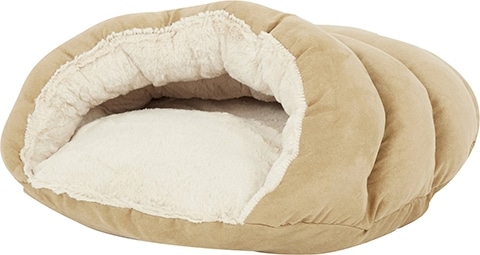
The Ethical Pet Cat Cave Bed has a slightly different design from most other beds on this list. The front is relatively low and allows for more burrowing, unlike other cave beds that closely resemble actual caves. This one is more similar to a sandwich. It is made out of high-quality material and follows a strict manufacturing process. The exterior is made with a soft micro-suede, while the inside is a plush faux fur.
The deep pocket ensures that your feline can cuddle and burrow as much as it likes. However, if your feline isn’t one for burrowing, then this might not be the right bed for you.
The stuffed filling is made of 100% recycled material. It will not shift or clump so it will maintain its original shape quite well. The bed is currently available in three earth-tone colors. The bed is also machine-washable.
- Micro-suede exterior
- Deep pocket for burrowing
- Filling is 100% recyclable
- Three colors available
- Some cats may not like the “sandwich” design
- Not particularly big
6. Pet Magasin Self-Warming Cat Cave Bed
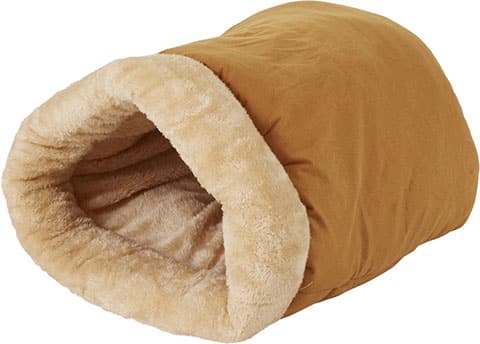
The Pet Magasin Self-Warming Cat Cave Bed looks like a giant sleeping bag for cats. The interior is made of faux fur with fleece and foam padding. The outer shell is made of microfiber. You can reconfigure this bed into different styles: a burrito-style bed, an upright cup, a flatbed, or a snuggly pod. If your cat doesn’t like one of the styles, you can easily switch it to something else. The burrito is perfect for felines like snuggling, but others may feel a bit confined and not like it. It depends on the feline.
This design is neutral, so it blends into any home design relatively easily. It features an anti-microbial design as well, so you don’t have to worry about bacteria and odors latching onto the bed. The foldable design makes storage very easy as well, which is perfect if you only need to bring this bed out sometimes.
Cats of all shapes and sizes are suitable for this bed. It works for kittens as well as larger felines.
- Four designs
- The outer shell is made of microfiber
- Includes fleece and foam patterns
- Neutral design
- The bed is not heated, despite the label
- Might not fit giant cats
7. PETMAKER Tent Igloo Cat Cave Bed
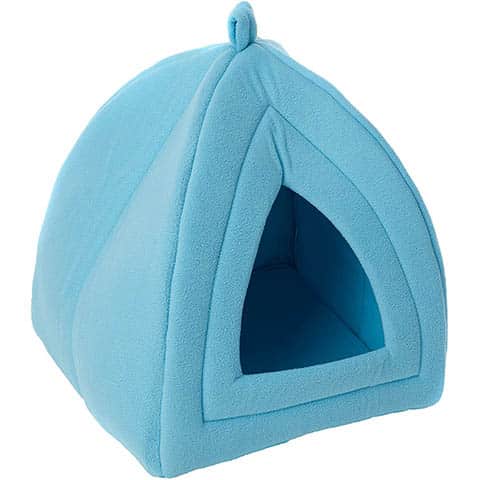
For those looking for a cheaper bed, the PETMAKER Tent Igloo Cat Cave Bed might be a suitable option. It is cheaper than most other options out there while still being suitable for some cats. It has a wide opening and a taller roof. This makes it better for cats that don’t like burrowing but do like the enclosed feeling of a cave bed.
This bed currently comes in two different colors. Both are quite bright, so it may be a bit difficult to fit it in with your current home décor. There is an insertable pillow that you can remove for easy cleaning. The cover is made out of 100% polyester, while the filling is made with polyurethane foam. There isn’t as much suede or anything of that sort with the bed, making it less suitable for some cats.
It is pretty significant but still won’t be suitable for enormous cats. If your cat is vast, you should likely look elsewhere.
- Wide opening and tall roof
- Two different colors available
- Washable
- Not for huge cats
- Only bright colors available
8. Bedsure Kitten Bed Cave
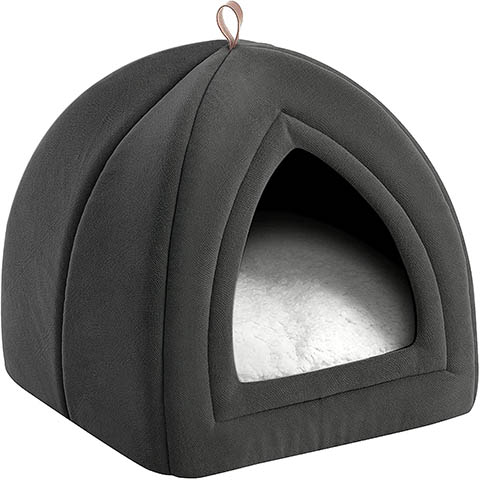
The Bedsure Kitten Bed Cave is soft and fluffy. It is suitable for pets up to 11 pounds, which means that only smaller cats will fit in it appropriately. Large cats will quickly be too big, so you should choose a larger bed for these felines. This bed is made of high-density foam and microfiber. The bed is more tent-shaped, so it is suitable for those who don’t particularly like the burrow. There is a soft cushion inside the bed. This can be easily removed for cleaning purposes. It can also simply be used elsewhere if your cat doesn’t like it inside the tent.
The bed folds down for storage, or if your feline would instead use it while lying flat. The leather handle also makes it easy to move around as you need to. An anti-slip bottom prevents it from moving around as your feline moves or jumps into the bed. It’s black and exceptionally stylish, so it should fit most home décor schemes.
- Made of high-density foam and microfiber
- Removable pillow
- Folds for storage
- For only tiny cats
- Pillow cover is not removable
9. Armarkat Cat Cave Bed
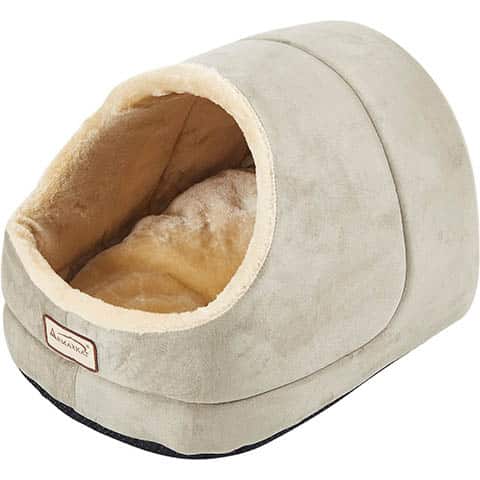
The Armarkat Cat Cave Bed is waterproof and has an anti-skid base, so it won’t roll around when your cat wiggles in it. It is made with velvet fabric and plenty of cushions. It is filled with extra-thick polyfill to create a cozy bed for your feline. It is also machine washable for easy cleaning. It is big enough to fit most cats and even small dogs. However, it may be too large for enormous cats, as it is a bit on the smaller side.
This bed is incredibly soft, largely thanks to the velvet. This bed also comes in three different colors—all of which should fit easily into most home designs. It isn’t expensive either, which is always a plus.
The bed doesn’t tend to hold its shape very well, however. Instead, it tends to flatten over time, which makes it less durable than other beds. It’s also tiny. We recommend it for cats under 10 pounds. It may be a bit cramped otherwise. While they are machine washable, the cushions don’t seem to stand up to washing very well.
- Velvet fabric
- Inexpensive
- Filled with polyester
- Tends to flatten overtime
- Small
- Not really machine washable
10. Twin Critters Handcrafted Cat Cave Bed
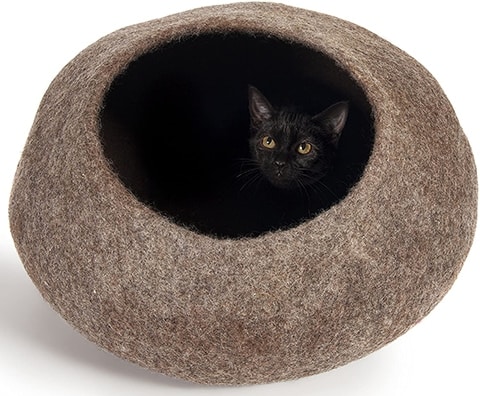
The Twin Critters Handcrafted Cat Cave Bed comes in some pretty funny configurations. You can choose just a plain wool bed, but they also have one that looks like a dog and another one that looks like an anglerfish. It’s pretty entertaining.
This felt cat cave bed is quite large, so it should fit cats of all sizes. It is made out of merino wool, which is wet felted into shape. This involves putting wool into the water and using soap to make the wool fibers shrink and stick together. That means it is one giant piece of wool—no stitches or anything of that sort. This makes it more durable, as there are no pieces to fall off. It is handcrafted by artisans in Nepal and made with New Zealand wool. The bed is made without any harsh chemicals, so it is entirely safe for your feline.
It is incredibly soft and breathable. The wool will keep your feline warm in the winter and cool in the summer. The wool will keep its shape quite well since it has been wet felted.
- Funny pattern options
- Large
- Made completely of wool
- Will be flattened if pressure is applied
- A bit pricey
- Doesn’t hold its shape super well
Buyer’s Guide: Selecting the Best Cave Beds for Cats
When choosing a cat cave for your feline, there are a few things you need to know. Not all of these beds are made the same. They all have a “roof,” which allows your cat to feel safe and contained. However, that’s about where the similarities end.
We’ll take a look at everything you need to know about this feline bed so that you can choose the perfect option for your feline.
Shape
How exactly a “cave” bed is shaped differs. Some have very high roofs and look like tents. These beds are suitable for cats that want to feel like they’re hiding but not necessarily burrow into a bed. Others have the top-down very low so that the cat can snuggle into the bed and dig—some cats like this more than others.
If you purchase a cat bed with a low bed, but your feline doesn’t like to snuggle, they likely won’t use it. It is essential to purchase a bed that is suitable for your cat. It has to match their sleeping style.
Size
Just because a bed is designed for cats doesn’t mean it is fitting for all cats. Some beds are only suitable for smaller cats, which are usually defined as cats under 11 pounds. Others are quite large. This is great if you have a large feline, but smaller ones may not enjoy the giant inside of a massive bed, especially if they prefer to snuggle. Bigger is not always better.
Instead, you need to choose a bed that fits your cat’s size. If you have multiple cats, choose one that can fit all of them, including the largest one.
Washability
Some cat beds are entirely washable, while others are not. Some have certain pieces that are washable, though other pieces are not washable. Preferably, you want a bed that is as washable as possible. Machine washable is preferred, as you likely don’t want to spend time washing the bed by hand.
You know how dirty your feline is, though. Older cats may especially need a washable bed, as they may have more accidents. Kittens also tend to be particularly messy, as they may suck or nibble on the cat bed. You should choose a washable bed in these circumstances. If your cat is an adult, you may not need to invest much in a washable bed.
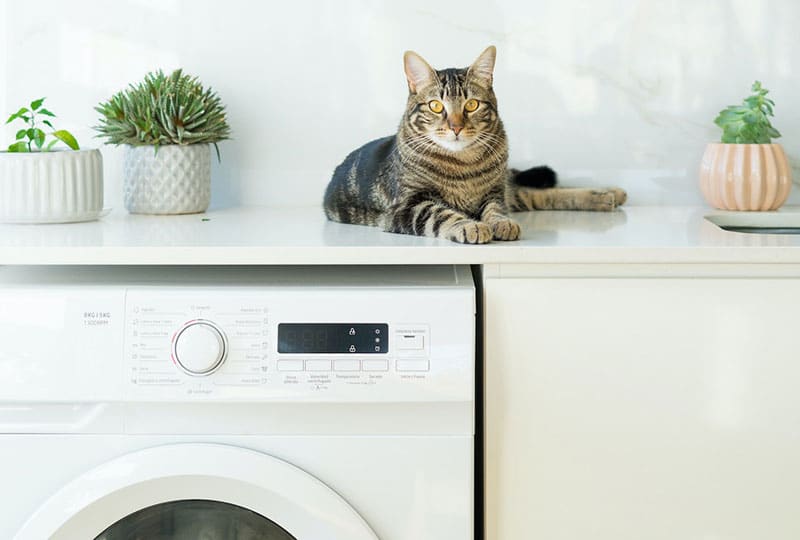
Waterproof
Some cat beds are waterproof; others are not. If your cat is older and may have accidents, a waterproof cat bed is necessary. Otherwise, you may not need a waterproof cat bed, though it is still an excellent option to have.
Some beds have liners inside that protect the stuffing from urine and other liquids, though the outside will still get wet. This does save the stuffing, though, which is the most important thing to consider.
Durability
Some beds are highly durable. They are practically indestructible. Others don’t stand up to washing or even regular use very well. Sewing may fray and become undone, which can be a severe problem. If your cat loves a bed, the last thing you want to do is for it to break. Beds aren’t cheap either, so don’t waste your money on a bed that will fall apart after a little bit.
We recommend looking for beds made with high-quality materials. These tend to stay together for the longest.
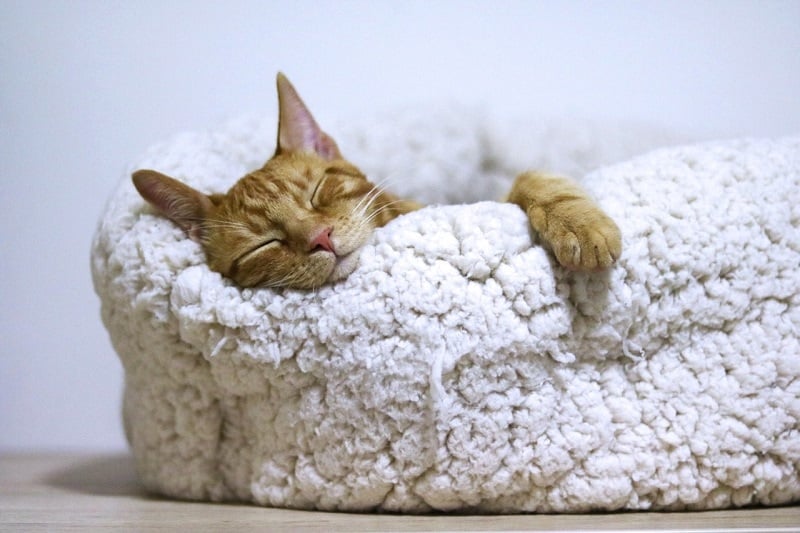
Do Cats Like Cave Beds?
Some cats like cave beds. Cave beds provide a roof and usually have three sides. They can make the cat feel like they’re hiding, which will allow some cats to rest a bit better. Skittish cats and those that tend to hide may like these caves more than others.
However, other cats do not like cave beds. They make them feel trapped. Often, these cats won’t use these beds at all. Instead, they’ll prefer to sleep on open surfaces, like flat cat beds.
The only way to know whether or not your feline will like a cave bed is to give it a try. Some cats will start using it right away, while others won’t use it at all. Some may need a chance to warm up to it or see another cat using it. Then, they may start using it themselves. It varies from cat to cat, though. Some will never be fond of these beds no matter what you do.
Where is the Best Place to Put a Cat Bed?
Somewhere out of the way. You don’t want to put your cats’ bed somewhere trafficked, as they may not use it. Cats tend to like to rest in corners and places where people usually don’t hang out. A cat cave bed can make them feel extra safe, though you will still need to put it somewhere out of the way.
You may also want to look for warmer places. This could be places where the sun hits or by a heater. You can look at places where your feline already rests on getting some ideas. Some cats prefer to be up high. You may need to get a cat bed that is self-standing or place a cat bed on a table or other piece of furniture so that they feel safe.
Conclusion
As you can see, there are a lot of options to choose from. We hope we’ve made your decision that much easier. In our opinion, the Hepper Pod Modern Cat Bed is the best overall cat cave bed on the market. Its sleek design looks great in the home and cats love the comfort. If you’re looking for the best value cat cave bed, look no further than the Frisco Cat Cave Bed, which gets the job done at a price you’ll love.
Featured Image Credit: Hepper.com
Contents
- A Quick Glance at Our Favorites in 2024
- The 10 Best Cat Cave Beds
- 1. Hepper Pod Modern Cat Bed – Best Overall
- 2. Frisco Cave Covered Cat Bed – Budget Buy
- 3. Snoozer Pet Products Cat Cave Bed
- 4. Meowfia Premium Cat Cave Bed
- 5. Ethical Pet Cat Cave Bed
- 6. Pet Magasin Self-Warming Cat Cave Bed
- 7. PETMAKER Tent Igloo Cat Cave Bed
- 8. Bedsure Kitten Bed Cave
- 9. Armarkat Cat Cave Bed
- 10. Twin Critters Handcrafted Cat Cave Bed
- Buyer’s Guide: Selecting the Best Cave Beds for Cats
- Shape
- Size
- Washability
- Waterproof
- Durability
- Do Cats Like Cave Beds?
- Where is the Best Place to Put a Cat Bed?
- Conclusion

